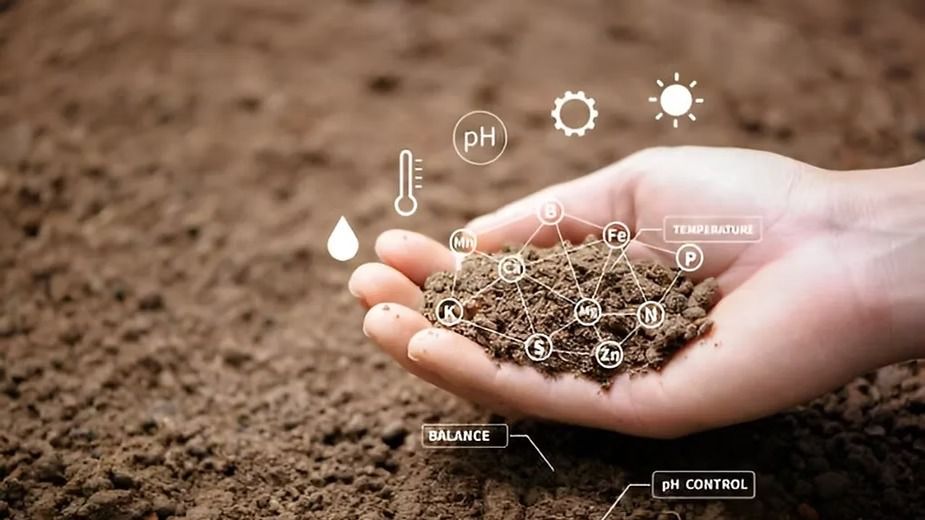Soil Quality Indicators and How to Improve Them: A Comprehensive Guide
Published on July 28, 2025

What is Soil Quality?
Soil quality is defined by its capacity to support plant and animal productivity while preserving environmental health. This concept encompasses the soil’s physical, chemical, and biological properties that are crucial for its overall performance and vitality. Healthy soil is the foundation of successful agriculture, which in turn supports ecosystems and environmental stability.
Agriculture, an ancient practice dating back thousands of years, began as a means to cultivate plants and domesticate animals for food and resources. The early farmers discovered that the success of their crops depended heavily on the quality of the soil they worked with. Soil quality was recognized as a key factor that influenced crop yields and farm productivity. As agriculture evolved, so did the understanding of soil’s role in supporting life. Today, soil remains central to agricultural success, influencing not only crop growth but also water management, soil erosion, and biodiversity.
Why Does Soil Quality Matter?

Soil quality is the cornerstone of successful agriculture and a balanced environment. Here’s why it’s essential:
- Plant Growth: Quality soil is the bedrock of robust plant growth. It provides a stable foundation for roots to anchor and access vital nutrients and water. Monitoring soil quality indicators like nutrient levels, pH balance, and organic content is essential for assessing soil health. These indicators help determine if your soil supports vibrant plant life or if you need to improve soil quality. Regularly evaluating and adjusting based on these indicators ensures your garden or farm achieves optimal productivity and lush, thriving greenery. By understanding and enhancing these soil quality indicators, you set the stage for stronger, healthier plants and better crop yields.
- Water Management: Effective water management begins with assessing soil quality. High-quality soil absorbs and retains water efficiently, reducing runoff and preventing erosion. To gauge this, monitor soil quality indicators such as texture, moisture levels, and drainage capacity. These indicators help you understand how well your soil manages water and highlight areas where you may need to improve soil quality. Enhancing these aspects through practices like adding organic matter ensures that water is used more efficiently, supporting healthier plants and reducing erosion risks. Regularly checking these soil quality indicators can help you maintain optimal water management in your garden or farm.
- Environmental Health: Healthy soil plays a crucial role in environmental sustainability. It supports biodiversity and aids in carbon sequestration, helping to mitigate climate change. Soil quality indicators, such as microbial activity and soil structure, are essential for understanding how well your soil performs in these environmental roles. By regularly assessing these indicators, you can gauge and improve soil quality, enhancing its environmental benefits. Implementing practices that reduce chemical use and increase organic matter can further support soil’s role in reducing greenhouse gas emissions and promoting a balanced ecosystem. Tracking soil quality indicators ensures your soil contributes positively to environmental health.
Types of Soil Quality Indicators
Soil quality indicators are key to assessing soil health and functionality. They can be categorized into three main types:
Physical Indicators:
- Soil Texture: Soil texture, determined by the proportion of sand, silt, and clay, affects water retention and drainage. For example, sandy soils drain quickly but may require more frequent watering, while clayey soils retain moisture but may suffer from poor aeration.
- Soil Structure: The arrangement of soil particles into aggregates influences aeration and root penetration. Well-structured soil promotes better root growth and improves the soil’s ability to absorb and hold water.
- Bulk Density: This measures soil compaction, which impacts root growth and water movement. Lower bulk density usually indicates loose, well-aerated soil, while higher bulk density can lead to poor root development and reduced water infiltration.
Chemical Indicators:
- pH Levels: Soil pH affects nutrient availability and microbial activity. Soils that are too acidic or too alkaline can lead to nutrient deficiencies or toxicities. Regular pH testing helps maintain optimal levels for plant growth.
- Nutrient Content: Essential nutrients like nitrogen, phosphorus, and potassium are crucial for plant health. Soil tests provide insights into nutrient levels, enabling you to amend the soil with fertilizers or organic matter as needed.
- Organic Matter Content: Organic matter, such as decomposed plant and animal material, enhances soil fertility, water-holding capacity, and structure. High organic matter content is often associated with healthier, more productive soils.
Biological Indicators:
- Microbial Activity: Soil microorganisms play a vital role in nutrient cycling and organic matter decomposition. High microbial activity indicates a healthy soil ecosystem that supports plant growth.
- Earthworm Activity: Earthworms improve soil structure by creating channels that enhance aeration and drainage. Their presence is a positive sign of good soil health and productivity.
How is Soil Quality Being Measured?

Measuring soil quality involves various methods and tools to assess its physical, chemical, and biological properties:
1. Soil Testing
When it comes to understanding soil health, soil testing is a game-changer. By sending soil samples to a lab, you get a deep dive into critical soil quality indicators like pH levels, nutrient availability, and organic matter content. This detailed analysis is your blueprint for how to improve soil quality. It tells you exactly what amendments your soil needs—be it lime to balance acidity or compost to boost organic matter. Regular soil testing ensures that you’re not just guessing but making informed decisions that enhance soil fertility and productivity.
2. Field Observations
Sometimes, the best insights come from getting your hands dirty. Field observations let you see firsthand how soil behaves under different conditions. By examining soil texture, structure, and biological activity, you can spot signs of trouble like erosion, compaction, or nutrient deficiencies. These visual cues are crucial soil quality indicators that help you understand how to improve soil quality effectively. Whether you’re checking for waterlogging or assessing root health, these observations guide you in making adjustments to keep your soil in top shape.
3. Soil Health Assessment Tools
Modern technology offers a range of soil health assessment tools to make monitoring a breeze. Penetrometers measure soil compaction, while moisture meters gauge water content, both of which are key soil quality indicators. These tools provide real-time data, helping you keep tabs on soil conditions without constant manual checks. By using these tools, you can pinpoint exactly where improvements are needed, whether it’s adjusting compaction levels or ensuring optimal moisture. Effective use of these tools ensures that your soil remains healthy and productive, ultimately enhancing your overall land management strategy.
Selecting Soil Quality Indicators
Choosing the right soil quality indicators depends on several factors:
1. Soil Type and Use
Understanding your soil type is crucial because different soils have unique needs when it comes to maintaining health and productivity. Whether you’re dealing with sandy soil, clay, or loam, selecting the right soil quality indicators is key. For instance, sandy soils might require close monitoring of water retention and organic matter, while clay soils may need attention to compaction and drainage. Tailoring your approach based on soil type and land use helps you better understand how to improve soil quality, ensuring that the specific needs of your soil are met for optimal plant growth.
2. Agricultural Goals
When selecting soil quality indicators, aligning them with your agricultural goals is essential. If you’re growing nutrient-hungry crops like vegetables, focusing on nutrient levels and pH balance is critical. For crops that require well-drained soil, such as root vegetables, soil structure and water infiltration become priority indicators. By understanding your specific crop requirements and farming practices, you can choose indicators that directly impact your agricultural success. This targeted approach not only helps improve soil quality but also enhances your crop yields and overall farm productivity.
3. Environmental Concerns
Soil health isn’t just about growing plants; it’s also about protecting the environment. If you’re facing issues like soil erosion, runoff, or loss of organic matter, selecting soil quality indicators that address these environmental concerns is vital. For example, indicators that monitor soil cover, compaction, and organic matter content can help you take proactive steps to reduce erosion and improve water retention. By focusing on these environmental aspects, you can effectively manage your land while also contributing to a healthier ecosystem. This balanced approach ensures that your soil remains productive and sustainable in the long run.
How to Improve Soil Quality?
Improving soil quality involves targeted actions to enhance its physical, chemical, and biological properties:
1. Adding Organic Matter
Incorporating organic matter is one of the most effective ways to enhance your soil's health. Adding compost, manure, or planting cover crops can significantly boost organic matter content, which is a key soil quality indicator. This practice not only improves soil structure, making it easier for roots to penetrate, but it also increases nutrient availability, helping plants thrive. Additionally, organic matter feeds beneficial microbes, enhancing microbial activity, and improving water retention, both of which are crucial in understanding how to improve soil quality for better crop yields and overall soil health.
2. Adjusting pH Levels
Maintaining the right soil pH is essential for optimal plant growth, as it directly influences nutrient availability. If your soil tests reveal that pH levels are off, you can adjust them using lime to raise the pH or sulfur to lower it. Balancing pH is a vital soil quality indicator because it ensures that nutrients like nitrogen, phosphorus, and potassium are accessible to your plants. Proper pH levels also create a conducive environment for beneficial microbial activity, which is key to how to improve soil quality and keep your crops healthy and productive.
3. Practicing Crop Rotation
Crop rotation is a time-tested method for maintaining soil health and preventing issues like nutrient depletion and soil-borne diseases. By rotating different crops in your fields, you help balance nutrient levels, reduce the build-up of pests, and minimize the risk of diseases that can affect future crops. This practice is an important soil quality indicator as it helps maintain soil fertility and structure over time. Understanding how to improve soil quality through crop rotation can lead to more sustainable farming practices and healthier, more resilient soil.
4. Minimizing Soil Disturbance
Reducing soil disturbance is crucial for preserving soil structure and preventing erosion. Practices like no-till or reduced-till farming minimize the impact on the soil, keeping it intact and allowing it to maintain its natural structure. This approach is beneficial for reducing compaction, a key soil quality indicator, and helps retain moisture, making your soil more resilient. By learning how to improve soil quality through minimized disturbance, you contribute to a healthier soil ecosystem, which ultimately supports better plant growth and long-term sustainability.
Discover Sustainable Farming with Sannidhi Eco Farms: Managed Farmlands in Karnataka
Swasya Living's Sannidhi Eco Farms provides a unique opportunity for those interested in sustainable farming through managed farmlands. Located in Karnataka, these farms are meticulously maintained using advanced soil management techniques.
Swasya Living focuses on improving soil quality by incorporating organic matter, practicing crop rotation, and minimizing soil disturbance. These methods ensure that the soil remains fertile and productive, fostering healthy crops and a balanced ecosystem. By investing in Sannidhi Farms, you are not only securing a piece of land but also contributing to a sustainable agricultural practice that prioritizes long-term environmental health.
Conclusion
Understanding soil quality indicators and how to improve soil quality is essential for maintaining healthy, productive soil. By focusing on key physical, chemical, and biological indicators, you can assess soil health and implement effective management practices. Regular monitoring and targeted improvements will enhance soil fertility, support plant growth, and contribute to a sustainable environment. Embrace these strategies to transform your soil into a thriving foundation for successful agriculture and a balanced ecosystem.
